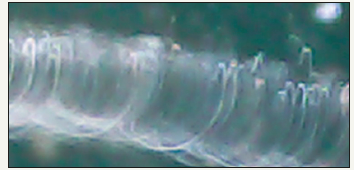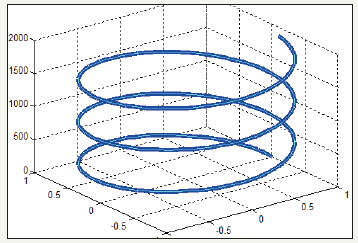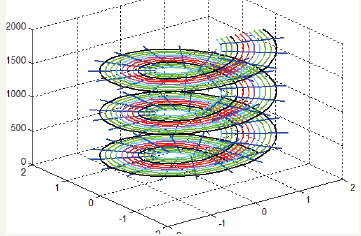- Submissions

Full Text
Determinations in Nanomedicine & Nanotechnology
Nanoengineering and Maxwell’s Equations
Solomon I Khmelnik*
Department of fuel-free energy, Israel
*Corresponding author: Solomon I Khmelnik, Department of fuel-free energy, Israel
Submission: January 24, 2019;Published: February 01, 2019

ISSN: 2832-4439 Volume1 Issue1
Annotation
It is shown that the fine structure of currents, electric and magnetic fields, energy fluxes in nanostructures can be studied on the basis of the new solution of Maxwell’s equations. At present, nanoengineering is rapidly developing, the subject of research of which is engineering developments at the nano level. If we are talking about the development of electromagnetic devices, then we can talk about nanoelectronics and, in general, about Nano electrodynamics. In the transition to the molecular level, one should speak of molecular electronics and quantum mechanics. But we will stop at the level where you can still talk about currents, electric and magnetic fields, energy flow, wires, resistors, capacitors, magnets. At the nano-level, it is necessary to take into account the structure of currents and fields. For example, in Figure 1 shows a photograph of a wire moistened with magnetic fluid (magnified 20times). One can see the spiral lines formed in the magnetic fluid. This photograph indicates the existence of spiral lines of magnetic intensities (Figure 1).
The fact of existence around a conductor with a constant current of a magnetic field, having a spiral-like configuration, was established by Oersted in 1820, but there is no explanation. Such structures are not predicted and are not explained by the existing theory. The electric current is represented by the turbulent motion of electrons, and the flow of electromagnetic energy is something that flies parallel to the side of the wire [1]. Meanwhile, electrodynamics, in essence, is a consequence of Maxwell’s equations. However, the existing solutions of this system do not allow to find an explanation. There are other known problems with existing solutions. Suffice it to say that these solutions do not satisfy the law of conservation of energy. Such solutions allow some authors to doubt the reliability of the Maxwell equations themselves. We emphasize, however, that these dubious results follow only from a well-known decision. But the solution of Maxwell’s equations can be different (partial differential equations, as a rule, have several solutions). And it is necessary to find a solution that does not contradict the physical laws and empirically established facts.
The author has found a new solution of the Maxwell system of equations, free from the indicated disadvantages [2]. This solution is found for the Maxwell equations, written in coordinate form, and cannot be obtained in a vector form from the Maxwell equations, written in a vector form. This, apparently, was the reason that the proposed solution has not yet been received. The solution obtained allows us to consider the fine structure of currents and fields and due to this take into account such phenomena as the effect of magnetic flux on the flow of electrically charged liquids at different meeting angles, the effect of an electromagnetic field on an ensemble of molecules-electric dipoles, etc. It will be possible to develop a rigorous theory of a molecular electric motor and an electric generator, etc.
Figure 1:Shows a photograph of a wire moistened with magnetic fluid (Magnified 20times).

Figure 2:Shows Helix Lines for different radius values.

Based on the new solution of Maxwell’s equations, the spiral structure of electromagnetic waves and stationary electromagnetic fields was theoretically predicted and experimentally confirmed, and it was also shown that spiral structures exist in all waves and technical devices without exception. The spiral nature of the structures is expressed in the fact that coordinate-wise electric and magnetic intensities of waves and field vary with coordinates and time (for waves) in terms of sinusoidal functions. For illustration in Figure 1 shows a helix of a given radius at which the intensities remains constant. In Figure 2 shows helix lines for different radius values. The straight lines show the geometric locations of the points with equal phase. In Figure 3 shows in Cartesian coordinates the electric E and magnetic intensities of the N wave (Figure 2 & 3).
Figure 3:Shows in Cartesian Coordinates the Electric E and Magnetic Intensities of the N Wave.

Consider some of the phenomena that are detected and\or explained “at the Tip of the Pen”:
A. The flow of electromagnetic energy inside the wire,
B. Moment of impulse in magnet,
C. Torque in the wire,
D. Charge of a capacitor by a longitudinal magnetic field,
E. Charge of a capacitor by a circular magnetic field,
F. Wire in a longitudinal magnetic field,
G. Wire in a circular magnetic field,
H. Wire in a transverse magnetic field,
I. Magnetic field in a charged capacitor,
J. Non-electromagnetic induction (as a consequence of the magnetomotive force),
K. Longitudinal magnetic tension in the cavity of a tubular conductor,
L. Energy flow, as an electromotive force,
M. The nature of the potential energy of the capacitor,
N. Energy conservation in a ferromagnet.
These phenomena can be detected at the nanoscale in a living organism. They can also be used to construct nanomechanisms.
References
- Feynman RP, Leighton RB, Sands M (1964) The Feynman Lectures on Physics 6:
- (2018) Inconsistency Solution of Maxwell’s Equations, Lulu Inc, USA, p. 214. ISBN 9781365239410.
© 2018 Solomon I Khmelnik. This is an open access article distributed under the terms of the Creative Commons Attribution License , which permits unrestricted use, distribution, and build upon your work non-commercially.
 a Creative Commons Attribution 4.0 International License. Based on a work at www.crimsonpublishers.com.
Best viewed in
a Creative Commons Attribution 4.0 International License. Based on a work at www.crimsonpublishers.com.
Best viewed in 







.jpg)






























 Editorial Board Registrations
Editorial Board Registrations Submit your Article
Submit your Article Refer a Friend
Refer a Friend Advertise With Us
Advertise With Us
.jpg)






.jpg)














.bmp)
.jpg)
.png)
.jpg)










.jpg)






.png)

.png)



.png)






